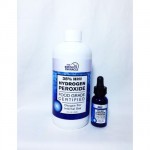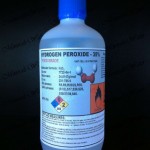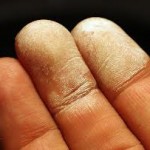TO MAKE A 3% HYDROGEN PEROXIDE SOLUTION
Mix 1 fl.oz 35% H2O2 to 11 fl.oz pure water
(or Mix 5 fl.oz 7% H2O2 to 7 fl.oz pure water)
this makes 12 fl.oz (3/4 pint) of 3% solution
(Use distilled water only)
35% Food Grade Hydrogen Peroxide
This grade is approved for use in the food industry as a nontoxic
disinfectant. Safely added to water, it is sprayed on cheese,
eggs, vegetables, fruits and whey products to keep them free
of unwanted bacteria. It is also used to disinfect aseptic food
containers (milk and juice boxes). It is also an ingredient in
contact lens cleaners, eye drops, aloe vera extracts, mouthwashes
and tooth-whitening products. In addition, food
grade hydrogen peroxide is used in the dairy industry as a
disinfectant and bactericide. Luckily, the FDA is unlikely to
remove hydrogen peroxide from the marketplace because,
without it, the agriculture and food processing industries
would pretty much come to a standstill.
The recommended methods of using hydrogen peroxide are in no way meant to be interpreted as medical advice, because hydrogen peroxide is not medicine. Hydrogen peroxide is not a“drug”. Hydrogen peroxide is a naturally occurring substance that is made by Mother Nature and is also made by every cell in your body. All information is designed to encourage you to realize that hydrogen peroxide is a necessary NUTRIENT that your body desperately needs.
In the Body, Hydrogen peroxide is made by quite a few enzymes . In
particular, some enzymes breaking down certain amino acids and fatty acids
(D-amino acid oxidase and acyl-CoA oxidase) make significant amounts of
hydrogen peroxide. Since hydrogen peroxide can be damaging to normal
tissue, these enzymes are kept inside specialized organelles inside cells
called peroxisomes. The peroxisomes also contain large amounts of catalase
to break down the hydrogen peroxide before it can escape. Other enzymes
that make significant amounts of hydrogen peroxide are plasma amine oxidase
and xanthine oxidase. In addition to enzymes that produce hydrogen peroxide
as part of their normal catalytic cycle, many enzymes that undergo
oxidation and reduction make hydrogen peroxide and other reactive oxygen
species by autoxidation (a kind of side-reaction that is not part of their
catalytic cycle). This happens quite a bit in the mitochondria.
Many of these autoxidation reactions do not produce hydrogen peroxide
directly, but rather superoxide (the product of adding one electron to an
oxygen molecule). In order to get rid of superoxide (which is more toxic
than hydrogen peroxide) the body also contains lots of superoxide
dismutase, that converts the superoxide into water and hydrogen peroxide.
One of the most interesting sources of superoxide in the body is that
produced by white blood cells when they encounter harmful microorganisms.
The white blood cells produce very large amounts of superoxide, hydrogen
peroxide, and even hypochlorous acid to kill pathogens.
Let’s Aid the Body to build a Strong Immune System.
Food contains nutrients that are vital to human health. Hydrogen
Peroxide is such a NUTRIENT. The food that you eat is deficient in hydrogen peroxide!
You should use liquid hydrogen peroxide as a daily nutritional supplement in order
to compensate for your dietary deficiencies.
Germs, parasites, fungi, bacteria and viruses
along with diseased and deficient tissue cells are all killed by
hydrogen peroxide. Healthy cells not only survive when the
concentration of hydrogen peroxide increases, but they
become stronger and healthier. The main difference
between human cells and pathogenic bacteria, viruses, fungi,
mold and parasites is that human beings (obviously) need
oxygen to survive, and pathogens tend to thrive in low oxygen
environments that accompany stagnation, decay and
death. This is due to their more primitive evolutionary origins
when the earth’s atmosphere was nearly devoid of oxygen.
When your oxygen levels drop below that which is
optimal for human life, your body becomes a growth medium
for pathogenic anaerobic organisms !
OXYGENATION
Oxygenation is simply increasing the amount or percentage
of oxygen. Breathing is the major way in which the body is
oxygenated. Deep Breathing is our quickest way to increase oxygen levels!
HYDROGEN PEROXIDE THERAPY
Over the past century, thousands of medical doctors have
infused dilute amounts of hydrogen peroxide into their
patients’ arteries, veins, mouths, noses, ears, vagina’s and
even their rectums. Hydrogen peroxide therapy can help
achieve a multitude of therapeutic benefits that would be
unthinkable with a single drug or mainstream medical procedure.
Simply put, hydrogen peroxide works medical miracles!
The list of ailments that have been and can still be treated
with hydrogen peroxide is unbelievably extensive.
Proved and researched with blood samples that doctors can hyper-oxygenate your bloodstream better with hydrogen peroxide than by breathing oxygen.
What’s our Dosage? Smart Question! First this shows attention to the topic. Knowing by testing is the general rule.
No one at “health food outlets” or in the “alternative medicine”
world recommends that concentrated hydrogen peroxide
should be used full strength. Of course that is dangerous.
Yes, it is true that less than a handful of people over the past
number of decades have mistakenly consumed concentrated
hydrogen peroxide, but let me ask you something. You
probably believe that it is generally safe to take one aspirin
if you have a headache. You probably think it is safe to put
a teaspoon of sugar in your coffee or tea. Right?
Would you take 700 aspirins? Of course not.
Would you put 700 teaspoons of sugar in your coffee?
Well, when you purchase a pint of Food Grade 35% hydrogen peroxide (CONCENTRATE)
That’s 700 times more concentrated than the amount that is considered safe.
This amount properly dispensed will last years! You buy a bottle of aspirin powder
and know and test your dosage level and you test your dosage when it comes to sugar and salt
so the same for Food Grade Hydrogen Peroxide.
If someone died after taking 700 aspirins, or got sick after
eating 700 spoonfuls of sugar, do you think that the FDA
would put out a warning regarding the dangers of taking
aspirin or using sugar at 700 times the safe dosage? Or
would that be stating the obvious?
With any substance, (including hydrogen peroxide) toxicity
is always dependent upon the amount used. Even too much
water can kill you (and not just by drowning)! Every year,
approximately 25 people die because they drink too much
water, it dilutes the electrolytes in their system, and the electrical
signals to their heart are unable to maintain proper
control of their heart beat.
The point is that anything and everything can be dangerous
if you use it improperly. Everything can be deadly. The
important issue is relative danger. Relative to pharmaceutical
products, hydrogen peroxide is amazingly safe.
What we need to do is continuously
put a harmless, weak solution of food grade hydrogen
peroxide into all water before it is used for drinking.
Doing this would eventually kill almost all waterborne
[pathogens] inside and outside the body. What would
happen to these anaerobic viruses and bacteria if they
were to be completely surrounded, or flooded, with a very
active, energetic and aggressive form of oxygen… slowly
and harmlessly introduced into the body on a daily basis,
over the course of a few months? What if we eventually
evenly saturated all the bodily fluids and cells with it?
Wouldn’t the disease causing microbes that can’t live in
oxygen cease to exist?”
Qualified practitioners are taught a very specific protocol. They use hydrogen peroxide that is prepared in a very specific way. To prepare the intravenous solutions, many physicians start with 30% reagent grade hydrogen peroxide. The 30% solution is diluted with an equal amount of distilled water to make a 15% solution. This 15% solution is passed through a Millipore 0.22mm medium flow filter for removal of particulate matter. One quarter of a milliliter of the 15% hydrogen peroxide is added to 100ml of 5% dextrose in water. This results in a 0.0375% hydrogen peroxide, 5% dextrose solution that is then used in the intravenous solutions. Some practitioners add other ingredients. Magnesium is commonly added because it seems to reduce the possibility of irritations at the injection site. Vitamin C is NOT added. The final solution is given intra-venously or intra-arterially.
TOP OF PAGE
A more extensive look at Food Grade Hydrogen Peroxide…….click this site http://www.foodgradehydrogenperoxide.com/index.html


